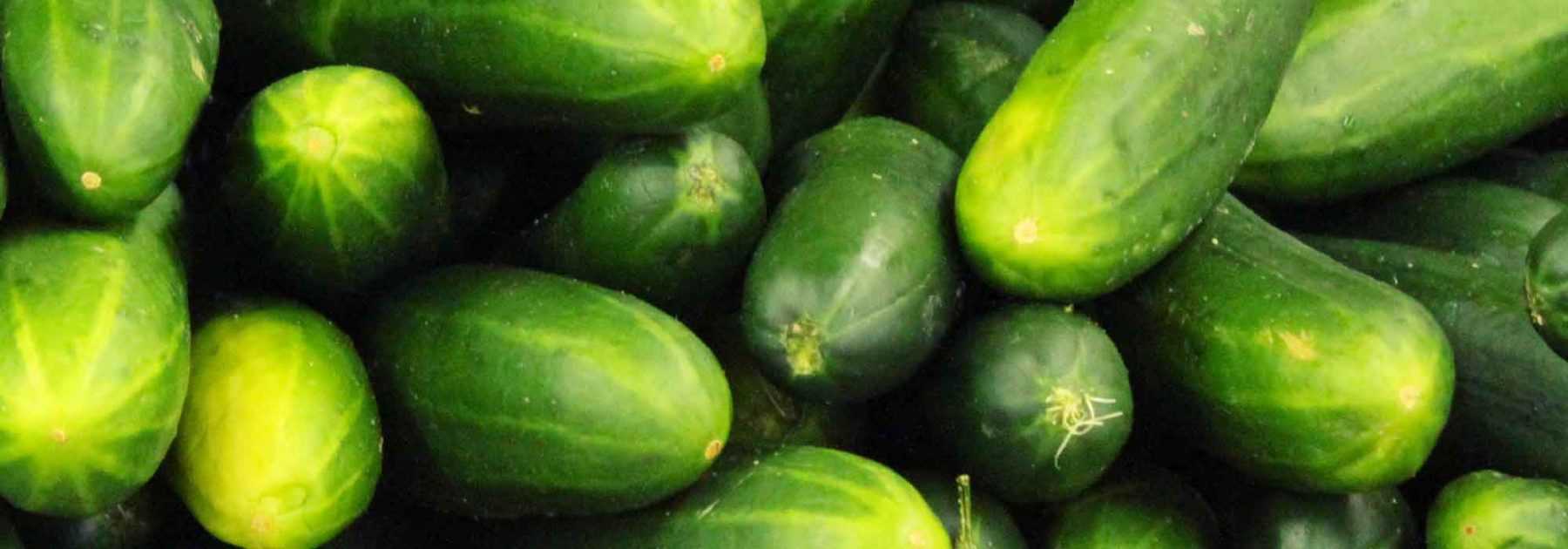
Cucumber and Gherkin: Sowing, Planting, Growing, Pruning
Contents
The cucumber and the gherkin in a few words
- Cucumbers and gherkins thrive in rich, humus-filled soil that is cool, loose, and light, with a sunny exposure.
- They both belong to the same species: gherkins are simply cucumbers harvested prematurely. Certain varieties are better suited for gherkin production.
- Sowing can begin as early as April, in pots and in warmth, or directly in the ground in May. Plants are transplanted into the garden after mid-May.
- These are fairly thirsty vegetables that require regular watering. They can be trained on supports to save space and make harvesting easier!
- Cucumber is a summer staple with its refreshing, mineral-rich, and low-calorie qualities! Gherkins are best enjoyed pickled in vinegar.
Our expert's word
The cucumber and the gherkin are two fruit-vegetables from the large Cucurbitaceae family, which includes many edible plants such as melons, courgettes, watermelons, etc. The cucumber is one of the star vegetables of summer; its refreshing and low-calorie nature likely explains its popularity. The gherkin is slightly less favoured as it needs to be pickled and accompanied by small onions, peppercorns and tarragon to bring out its full flavour. However, I can tell you that homemade gherkins are really worth the effort!
There are several types of cucumbers: Dutch varieties, which are grown under cover, such as the ‘Carmen’ variety, and short varieties suited to outdoor cultivation, like ‘Le Généreux’, a Vilmorin selection, and ‘Vert Long Maraîcher’, prized for its good yield and sweet, crisp white flesh.
Historically, gherkins are cucumbers harvested when small, with varieties later selected to suit gherkin characteristics. A typical and well-known variety is ‘Fin de Meaux’, which produces small fruits with excellent flavour. Also worth discovering is the ‘Russe’ gherkin, with smooth fruits to be harvested when egg-sized.
There are also less common, exotic cucumbers, such as the African Horned Cucumber or the Snake Cucumber, though these require considerable warmth to thrive. I must also mention Melothria, ideal if your cucumbers often suffer from disease. Indeed, this cucumber from a different botanical genus is highly resistant to diseases!
In the vegetable garden, cucumbers and gherkins prefer light, loose, moist and humus-rich soils. They thrive in sunny spots and temperatures between 18 and 22°C. These are fairly thirsty vegetables that require regular watering. They are also prone to certain diseases, such as powdery mildew and anthracnose… but by following our advice, you can prevent and treat these issues naturally.

Description and botany
Botanical data
- Latin name Cucumis sativus
- Family Cucurbitacées
- Common name Concombre
- Flowering Annuelle
- Height jusqu'à 10 ans
- Exposure Soleil
- Soil type riche, meuble, profond, frais en été
- Hardiness 0°C
The cucumber is a plant native to India where its wild ancestor (Cucumis hardwickii) grew in the Himalayan valleys. It was domesticated over 3000 years ago in China, the Near East and then in ancient Egypt. It arrived in Europe around 2000 years ago.
The cucumber – Cucumis sativus – is an annual fruit-vegetable belonging to the Cucurbitaceae family, which includes squashes and many cultivated plants. The Cucumis genus comprises around thirty known species, including melon (Cucumis melo). Gherkins are cucumbers whose varieties have been selected for their small fruits. Thus, we can classify cucumbers into different types:
- The Dutch type (or greenhouse cucumber): long fruits with smooth skin, without bitterness
- The short type (or field cucumber): short and slightly spiny fruits, some varieties are bitter
- Small pickling fruits: gherkins
- The Beit-alpha type: Mini-cucumber, smooth and shiny, without bitterness
The cucumber is a trailing plant that can spread over several metres. Its leaves with long petioles and large blades are palmate and slightly toothed. They are arranged alternately on the twining, pentagonal-section stem. Tendrils emerge from the base of the petiole, allowing the plant to cling to nearby supports. The cucumber is a monoecious species, bearing both male and female flowers on the same plant but at different locations. Both flower types are pale yellow. The female flower, which bears the fruit, is fertilised by pollen from a male flower of the same variety or another variety, with cross-fertilisation being predominant (allogamy). Pollination is also entomophilous, carried out by insects. A fertilised female flower will produce a fruit characteristic of the variety. The fruit is a cylindrical berry that produces pale, flattened seeds at maturity, about one centimetre long.
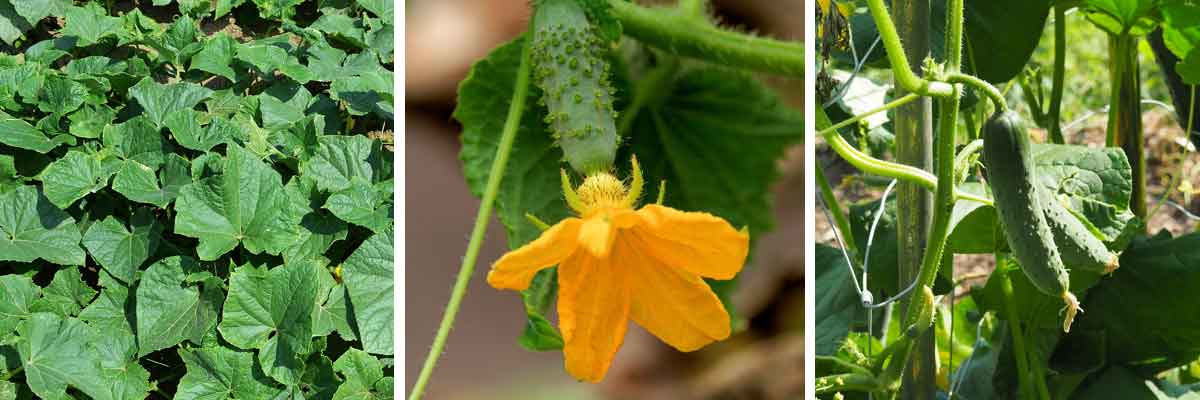
Cucumber leaves – Female flower – Formed fruit
Varieties of Cucumber and Gherkin
Most cultivated cucumber varieties are either Dutch-type or short-type, while gherkin varieties are selected for the flavour of their early-harvested fruits. Discover our selection of varieties!
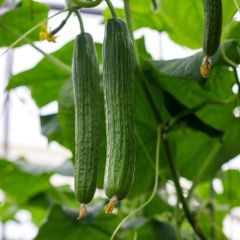
Cucumber Carmen - Cucumis sativus
- Flowering time June to August
- Height at maturity 2,50 m
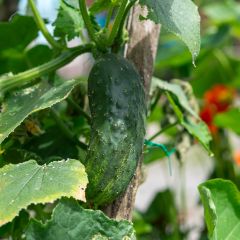
Cucumber Le Généreux - Vilmorin Seeds
- Flowering time June to August
- Height at maturity 2,50 m
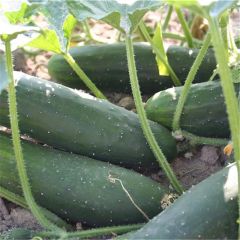
Cucumber Long English - Ferme de Sainte Marthe Seeds
- Flowering time June to August
- Height at maturity 2,50 m

Cucumber Marketmore - Vilmorin Seeds
- Flowering time June to August
- Height at maturity 2,50 m
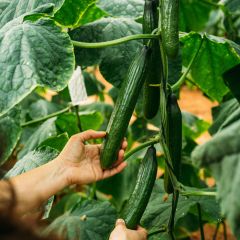
Cucumber Vert Long Maraîcher
- Height at maturity 2,50 m

Gherkin Hokus
- Flowering time June to August
- Height at maturity 2,50 m

Cucumber Fin de Meaux - Cucumis sativus
- Height at maturity 2,50 m

Gherkin Bourbonne - Ferme de Sainte Marthe Seeds
- Height at maturity 2,50 m

Gherkin Parisian - Ferme de Sainte Marthe Seeds
- Height at maturity 2,50 m

Gherkin Russe - Ferme de Sainte Marthe Seeds
- Flowering time June to August
- Height at maturity 2,50 m
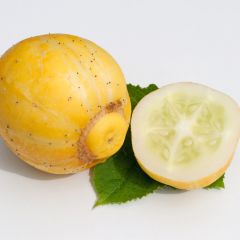
Cucumber Lemon
- Flowering time July to September
- Height at maturity 2 m

Melothria scabra
- Height at maturity 2,50 m
Discover other Cucumber seeds
Sowing cucumbers and gherkins
Where and When to Sow Cucumbers and Gherkins?
Cucumber and gherkin seeds are preferably sown in pots indoors with warmth, but can also be sown directly in the ground outdoors. These vegetables thrive in soil rich in organic matter, loose and deep. Prepare the planting bed by adding compost at a rate of 3 to 4 kg per m2.
Cucumbers and gherkins can be sown:
- from April to mid-May indoors with warmth, in the house or a heated shelter, under a greenhouse or on a hotbed.
- from mid-May to late June directly in the ground outdoors once the risk of frost has passed.
How to Sow Cucumbers and Gherkins?
You can either prepare seedlings to be transplanted into the vegetable garden once all risk of frost has passed or sow directly outdoors.
Preparing Seedlings:
- Fill pots or seed trays with a seed compost,
- Place two seeds per pot (flat) at a depth of about 1 cm and cover with compost,
- Water carefully using a watering can,
- Keep in a warm and bright spot (on a windowsill), at around 20°C (the germination range for cucumbers is between 16 and 35°C) and keep the substrate moist but not waterlogged until germination, which usually takes 7 to 10 days.
- Once the first two true leaves (cotyledons don’t count) are well developed, thin out by keeping the stronger of the two seedlings or separate them and repot into individual pots.
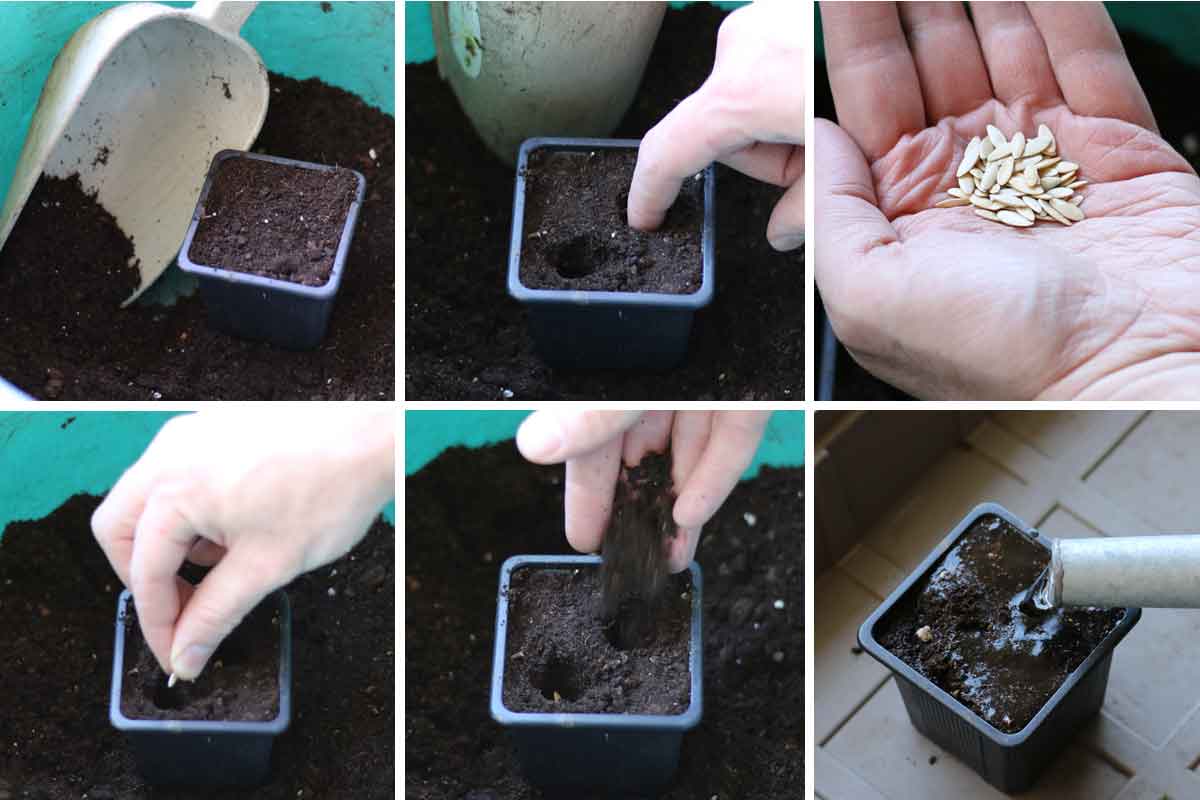
Steps for sowing cucumbers and gherkins in pots
Direct Sowing Outdoors:
- Make shallow furrows (3 cm deep), spacing rows 1 m apart.
- Sow in clusters of 2 seeds per hole.
- Along the row, space clusters 1 m apart if growing flat or 40 cm for gherkins and 60 cm for cucumbers if trellised.
- Cover with soil and firm down with the back of a rake.
- Water gently and keep the soil moist until germination.
- Once seedlings have 2 to 3 true leaves, thin out to keep only one plant per cluster.

Cucumber seedling – Cucumbers at the one to two true leaf stage
Planting cucumbers and gherkins
When to plant cucumbers and gherkins?
Cucumbers and gherkins should be planted from May onwards, after the Ice Saints, particularly in regions more susceptible to cold. In southern areas, they can be planted as early as mid-April, while keeping an eye on the weather and protecting them from late frosts with horticultural fleece if necessary. Planting can continue until the end of June.
How to plant cucumbers and gherkins?
These two vegetables require well-manured soil, previously enriched with compost or well-rotted manure at a rate of about 3 kg per m2.
Planting distances are 1 m between rows for both vegetables. Within the row, spacing should be:
- 1 m if grown flat on the ground
- 40 cm for gherkins if grown on a trellis
- 60 cm for cucumbers if grown on a trellis
To plant your cucumbers and gherkins:
- Dig a hole matching the size of the root ball,
- Place the root ball and cover with soil,
- Firm down and water to keep the soil moist,
- Water regularly at the base to help establishment.
Cultivation, care and companion planting
Cucumbers and gherkins need a sunny position to grow well. These hungry vegetables require rich soil, enriched with mature compost (3 kg per m²) at planting time or preferably in autumn. The soil should first be loosened and the compost worked in shallowly using a cultivator.
During cultivation, it’s good to weed but avoid hoeing too close to the plants. Indeed, cucumbers develop some of their roots near the soil surface, and hoeing can damage this dense root network. Opt for light weeding followed by applying a thick layer of mulch once the soil is sufficiently warm, in May or June. Cucumbers and gherkins can be trained on supports, and cucumbers can be pruned – we’ll detail this below.
As companion plants, cucumbers thrive near lettuces, which grow vigorously beneath them! They also benefit from being planted near onions, sweetcorn and beans. However, avoid planting them near other Cucurbits or potatoes. Pairing them with tomatoes yields mixed results.
→ Read also: Which plants to grow with cucumbers?
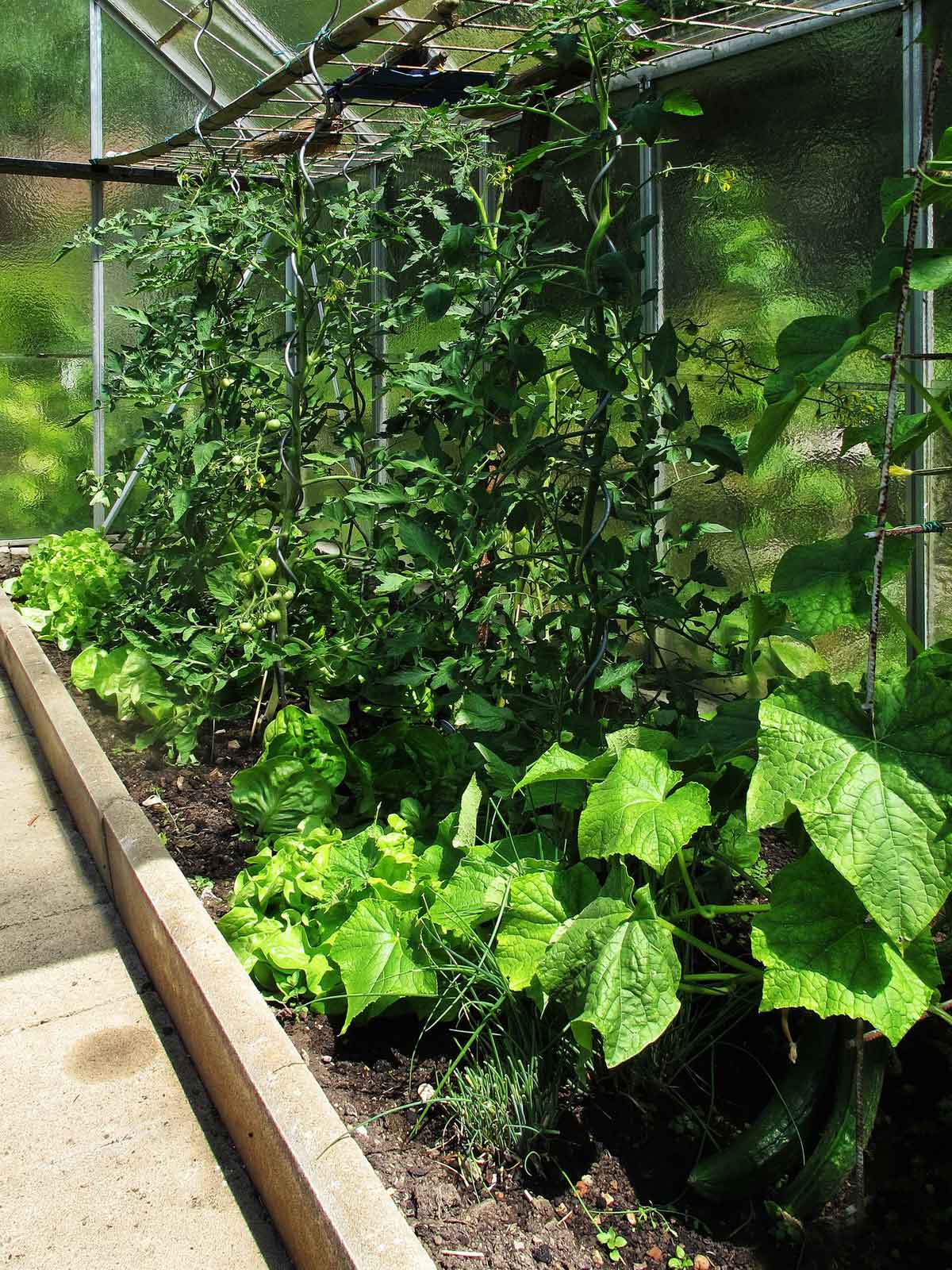
Greenhouse-grown cucumbers near tomato, lettuce and chive plants.
Staking and Pruning Cucumbers and Gherkins
Staking Cucumbers and Gherkins
Cucumbers and gherkins can be grown flat on the ground, but to optimise your crops, save space and make harvesting easier, don’t hesitate to stake or train them. There are several options for each variety.
For cucumbers:
- Using individual stakes, with one plant per stake.
- On a frame covered with mesh and tilted at 45° to provide shade for heat-sensitive summer crops like lettuces.
- In a teepee structure, with 3 to 4 stakes tied together at the top and one plant at the base of each stake.
For gherkins:
- On a large-mesh net, tilted at 45° or perpendicular to the ground.

Gherkins trained on a large-mesh net, perpendicular to the ground
Pruning Cucumbers
- When plants are individually staked, cultivation is done on a single stem, which should be pinched back to a maximum height of 2 m. Remove lateral shoots.
- For ground-level cultivation, the first pruning is done above the second leaf to encourage two stems, which should then be pinched back above the 4th leaf.
- When plants are trained on a trellis, guide and retain the lateral shoots. We recommend pinching stems after 2 or 3 fruits have formed on each lateral shoot.
NB: Pruning helps concentrate sap flow on fewer fruits. For gherkins, where the goal is to maximise the number of small fruits harvested, pruning is unnecessary.

Ground-level cucumber cultivation – Pinching to encourage lateral growth – Illustrations: Virginie Douce

Trellis-grown cucumber cultivation and pruning – Illustration: Virginie Douce
Common Diseases of Cucumbers and Gherkins
Powdery Mildew on Cucurbits
Cucumbers and gherkins can be affected by powdery mildew, a fungal disease that appears as a white felting on the foliage. Leaves dry out, production decreases, and in severe cases, powdery mildew can lead to plant death.
Anthracnose of Cucurbits
Anthracnose or red blight is a fungal disease caused by Colletotricum orbiculare, which affects cucurbits in general, particularly cucumbers, gherkins, and melons. Damage can be significant, halting plant growth and eventually causing death. Symptoms are very distinctive, with circular brown spots surrounded by a lighter, yellowish halo appearing on leaves. Anthracnose thrives in temperatures between 19 and 24°C during very humid periods.
- Regular monitoring is essential, as the disease can spread quickly. If you spot an initial outbreak, remove affected leaves and burn them.
- Preventive treatments for powdery mildew (bicarbonate, milk, horsetail) will also help prevent this disease.
→ Learn more about diseases and pests affecting cucumbers and gherkins in our advice sheet!
Harvesting and storing
Harvesting cucumbers, essential for any vegetable garden, should be done as needed. It’s best to pick them when they reach their ideal size or even slightly before, if you prefer to enjoy them without removing the seeds. Be careful, a cucumber that starts to yellow becomes bitter, a sign it has stayed on the plant too long. Regularly picking your cucumbers stimulates the plant to produce more fruit. Typically, harvesting begins 3 months after sowing, and a single plant can bear fruit for 2 months, providing a generous quantity of cucumbers.
For gherkins, harvesting also begins 3 months after sowing. It’s crucial to pick them before they reach their full size, ideally every two days during peak production, to prevent them from becoming too large. Just like with cucumbers, frequent picking encourages the growth of new fruit, ensuring an abundant harvest throughout the season.
As for storage, cucumbers can last up to 8 days in the refrigerator. For longer preservation, especially in case of a bountiful harvest, consider lacto-fermentation or pickling, techniques also applicable to gherkins. Once harvested, gherkins can be kept fresh for a few days before being pickled in vinegar, allowing you to enjoy their characteristic crunchy and tangy flavour all year round.
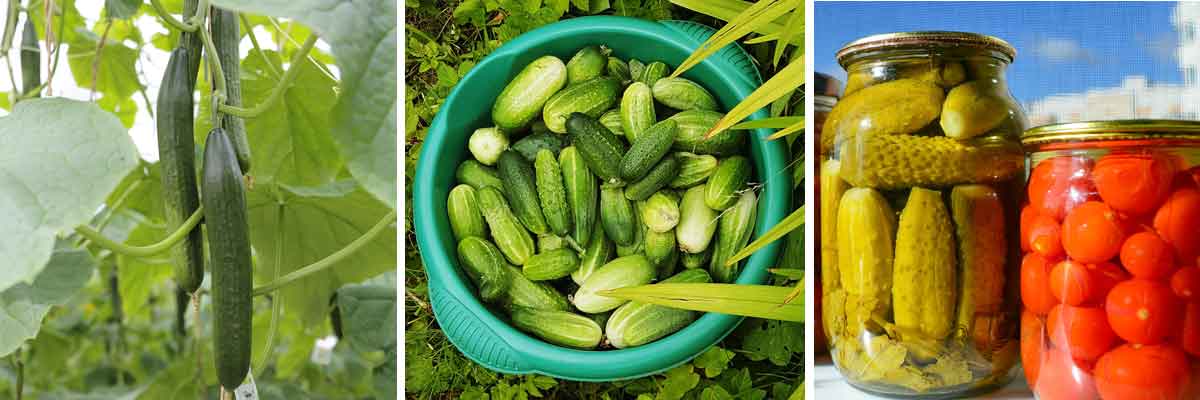
Cucumbers at the right stage for harvesting – Harvesting gherkins for pickling in vinegar
Uses and Nutritional Benefits
Cucumbers are mostly eaten raw in summer salads, pairing wonderfully with yoghurt or crème fraîche-based sauces, lemon, and fresh herbs from the vegetable garden like chives and dill. Cooked preparations are less common but possible – just a few minutes in the pan is enough. Juicing is also popular, ideal for dietary regimes. Gherkins are almost always pickled in vinegar, and this is undoubtedly the way they taste best!
Cucumbers and gherkins are low-calorie vegetables, consisting mainly of water (95%) and being rich in minerals (calcium, potassium, iron, magnesium). Water content is higher in cucumbers as gherkins are drained before pickling. Cucumbers are therefore remineralising and refreshing for the body. They also contain antioxidants, including citrulline, an amino acid that aids muscle protein synthesis (though watermelon naturally contains the highest levels of this amino acid). Their skin is entirely edible once thoroughly washed – it’s rich in pepsin, which aids digestion, so it would be a shame to discard it!
Frequently asked questions
-
Why are my cucumber plants producing very few fruits?
Cucumber plants that produce little are most likely poorly pollinated. To ensure a good harvest: - attract pollinating insects to your garden by sowing flowers that appeal to them, - avoid using pesticides.
-
Why are my cucumber leaves turning completely white?
This is most likely powdery mildew, a common disease affecting cucumbers and cucurbits. Please refer to the section above (paragraph on common diseases of cucumbers and gherkins) for prevention and treatment methods.
- Subscribe!
- Contents






































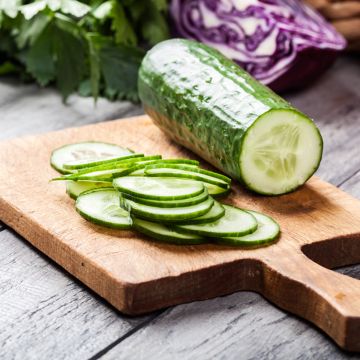
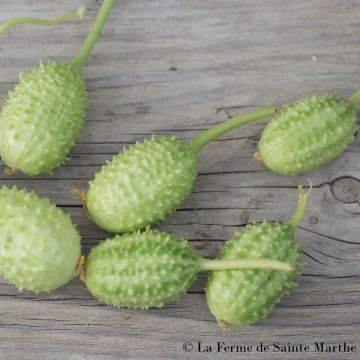
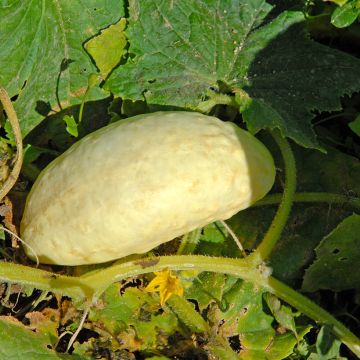
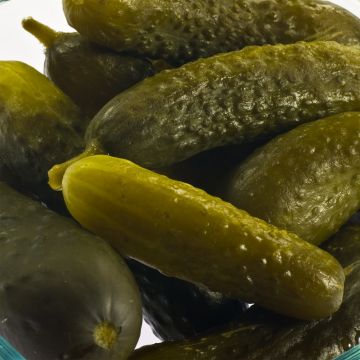
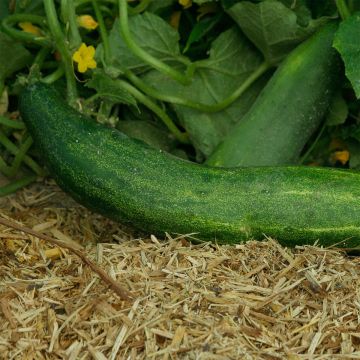
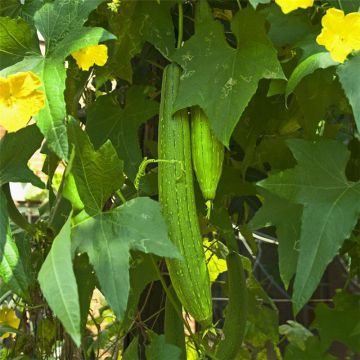
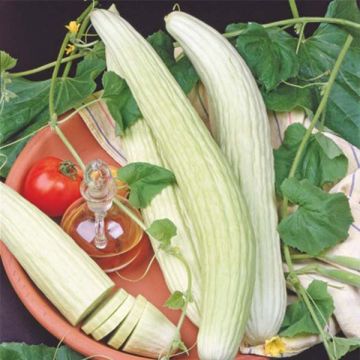
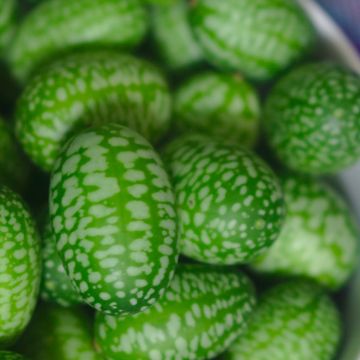
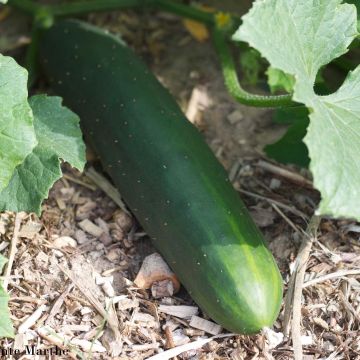


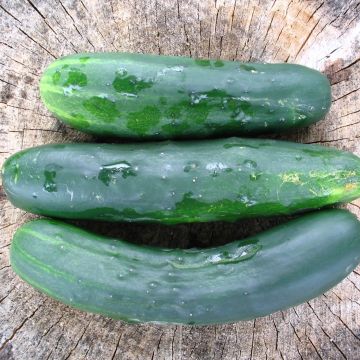
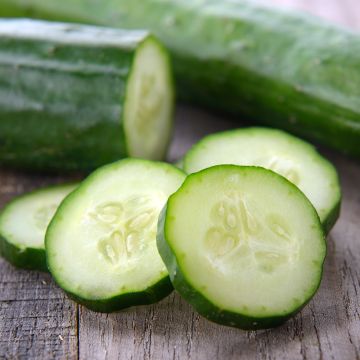
Comments